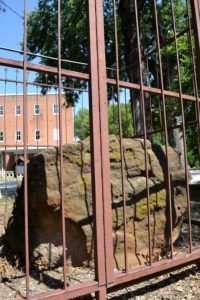FAQ
The Lindsborg Old Mill & Swedish Heritage Museum is a 501(c)3 nonprofit organization overseen by a board of directors. No county, city, or other government organization owns the museum or manages its operations.
Current major funding includes allocated dollars from McPherson County and the City of Lindsborg, as well as ongoing membership support, one-time donations, and grants. A small amount of the annual budget also comes from an endowment fund, admission fees, and gift shop sales.
The museum is also currently developing partnerships with – and sponsorship from – educational institutions, businesses, and corporations. Facilitating planned giving and estate gifts are also part of the museum’s strategic plan for sustainability.
The future of the museum will continue to rely on the generosity of people like you.
Admission is free for ages 0-5; $5 for students of any age; and $10 for general admission.
Additional freewill donations are always helpful and gratefully accepted.
(Admission costs effective February 1, 2023)
The museum is open 9 a.m. – 5 p.m., Monday – Saturday and is typically closed for major holidays.
We recommend allowing at least 30 minutes for touring through the mill and an hour for visiting all museum attractions.
The currently standing mill at the Lindsborg Old Mill & Swedish Heritage Museum is actually the third mill built on the site and operated 1898 to 1955, closing temporarily 1927 to 1934.
Charlie “Qvarn” Johnson built the Lindsborg community’s first water-powered grist flour mill in 1872.
With the mill flooded and largely washed away in 1881, it was rebuilt in 1882, then converted into a roller mill and expanded in 1886 as the Smoky Valley Roller Mills.
Five years later in 1891, flood waters swept out the dam, followed by an 1897 fire that consumed the mill.
Just six months later, Theodore Teichgraeber (who had become master of the mill in 1889) rebuilt the roller mill – the same building that stands on the site today.
The mill closed for seven years between 1927 and 1934, but grew and flourished post-Depression and into World War II. In the post-war period, larger regional mills increased competition in the milling industry, and Smoky Valley Roller Mills closed as an active business for the last time in 1955.
Yes!
Even though the machinery and structure of the mill is about 125 years old, it’s still functional!
For Millfest every year – on the first Saturday in May – the mill roars back to life and people can again see it in operation.
For preservation purposes, this is the only time of year the mill runs; and because of FDA requirements, wheat is no longer processed into flour in the historical mill. It is a dry-run, which means we turn all the machinery on but we are not grinding flour.
We give guided tours while it is in operation. You do need to be at least 13 years old to take the tour. We don’t allow children in the mill while it is operating because of safety concerns.
Read updates about Millfest HERE.
While this mill started as water-powered, it didn’t have the stereotypical “water wheel” with a horizontal axle – either “undershot” (water running underneath a wheel) or “overshot” (water flowing over the top of a wheel).
Instead, the mill was originally powered by water turbines, with a vertically oriented axle. Falling water would flow down into the turbines, then shoot out the bottom at an angle at high velocity, causing the turbines to spin.
With the river’s flow proving too unreliable, the mill added the option for steam power (which – on at least one occasion – exploded), then transitioned to fully electric power in the 1930s.
The first mill built on the site of the museum in 1872 was a “grist mill” – which uses the friction of two flat stones rotating against each other to grind down grain into flour. (You can see examples of these millstones in the main museum exhibit room and outside near the Mill Street gazebo.)
The existing roller mill, however, used a series of two corrugated metal cylinders rotating in opposite directions as well as filter screens to crush grain into smaller pieces and – eventually – flour.
Roller mills resulted in a cleaner product, more efficient production rates, and better handled the tougher hard winter wheat that became popular at the end of the 19th century.
At the close of the 1904 St. Louis World’s Fair, the Swedish Pavilion building was purchased by W.W. Thomas, U.S. Minister to Sweden and Norway. He presented to Bethany College in Lindsborg as a memorial to his friend Rev. Carl Aaron Swensson, who died suddenly in February 1904.
It served as a classroom for domestic sciences, library, museum and home to the art department for more than 60 years under Swedish born artist Birger Sandzen.
In 1969, the Swedish Pavilion was moved from Bethany College to the museum and a partial restoration was completed.
The First Street bridge between the museum and the campground closed in 2016 to motor vehicle traffic.
The campground is located west on Old Mill Road (Some online maps might also refer to it – incorrectly – as “Svensk Road”) from Business Loop 81 (Google Maps calls it 14th Avenue). This will take you directly to the campground.
Sometimes certain GPS apps will still try to direct motor vehicle traffic over the Välkommen bridge, which has been closed to everything but bicycles and pedestrians since 2016.
If you run into this situation, particularly if you are coming to us from the south, first make sure that you are on Highway 81 / 14th Avenue / Harrison (the main north/south road into the east side of Lindsborg). Then head north, going into Lindsborg. Take a left onto McPherson Street, then take a left again onto First Street – heading south. Keep following First Street until you see the closed bridge in front of you and the Lindsborg Municipal Pool on your right. Turn right onto Mill Street and you will see the Old Mill and the museum on your left.
Alternately, the link HERE should give you Google Maps directions from the Old Mill Campground (600 Old Mill Road) to the main museum building (120 E. Mill St.) via a correct, completely open route for motor vehicles.
Our apologies for any inconvenience and confusion; we actively work to correct these situations with wayfinding apps whenever they arise.
It is $15 per night with an electrical hookup (30 or 50 amp) and $12 per night without.
Typically campsites are first-come, first-served, although we will take reservations for major festivals, such as Svensk Hyllningsfest. Go to visitlindsborg.com for upcoming events.
There is a trail head and parking lot for the Välkommen Trail located behind the Swedish Pavilion on Lindsborg Street. It follows the abandoned Missouri-Pacific and Union Pacific rail beds. It is a 4-mile, all-weather trail. It connects with the Meadowlark trail at the south tip of the Old Mill Campground. The Meadowlark Trail is crushed limestone and is approximately three miles in length.

The rock was found in the early 1980s north of Lindsborg when a pipeline was being built.
It had what was thought to be petroglyphs or Native American carvings on the top. (There was debate at the time whether they were truly petroglyphs.)
It was moved to the museum and the fence installed to prevent vandalism.
It has now been exposed to the weather for many years, wearing down the carvings until they are extremely hard to see.
Believe it or not, those rocks are native to the hills north of Lindsborg!
They are actually iron ore; not volcanic.
